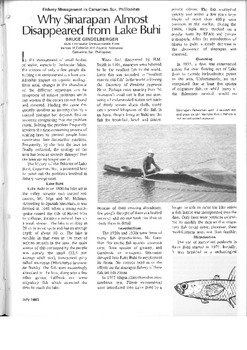Please use this identifier to cite or link to this item:
https://hdl.handle.net/20.500.12348/3681
Fishery management in Camarines Sur, Philippines: why Sinarapan almost disappeared from Lake Buhi
| dc.creator | Gindelberger, B. | |
| dc.date.accessioned | 2019-06-28T10:02:59Z | |
| dc.date.available | 2019-06-28T10:02:59Z | |
| dc.date.issued | 1981 | |
| dc.identifier | in_3431.pdf | |
| dc.identifier.citation | ICLARM Newsletter 4 (3): 3-5 | |
| dc.identifier.uri | https://hdl.handle.net/20.500.12348/3681 | |
| dc.description.abstract | In the management of water, especially freshwater lakes, the actions of only a few people disturbing the environment can have considerable impact on aquatic ecology. Even small changes in the abundance of the different organisms can be symptoms of serious problems which can worsen if the causes are not found and removed. Finding the cause frequently involves an investigation by a trained biologist but depends first on someone recognizing that the problem exists. Solving the problem frequently involves the time consuming process of making laws to prevent people from continuing their destructive practices. Frequently, by the time the laws are finally enforced, the ecology of the area has been so severely damaged that the laws are no longer useful. The history of the fisheries of Lake Buhi, Camarines Sur, is presented here to point out the problems involved in fishery management. | |
| dc.format | application/pdf | |
| dc.language | En | |
| dc.publisher | ICLARM | |
| dc.rights | CC BY 4.0 | |
| dc.source | ICLARM Newsletter | |
| dc.title | Fishery management in Camarines Sur, Philippines: why Sinarapan almost disappeared from Lake Buhi | |
| dc.type | Journal Article | |
| dcterms.bibliographicCitation | Gindelberger, B. (1981). Fishery management in Camarines Sur, Philippines: why Sinarapan almost disappeared from Lake Buhi. ICLARM Newsletter 4 (3): 3-5 | |
| cg.coverage.country | Philippines | |
| cg.identifier.worldfish | 3431 | |
| cg.subject.worldfish | fisheries management | |
| cg.contributor.affiliation | Bureau of Fisheries and Aquatic Resources Philippines | |
| cg.identifier.status | Open access | |
| cg.description.theme | Resilient small-scale fisheries | |
| worldfish.location.area | Asia |
